2004 FORD MUSTANG weight
[x] Cancel search: weightPage 88 of 240
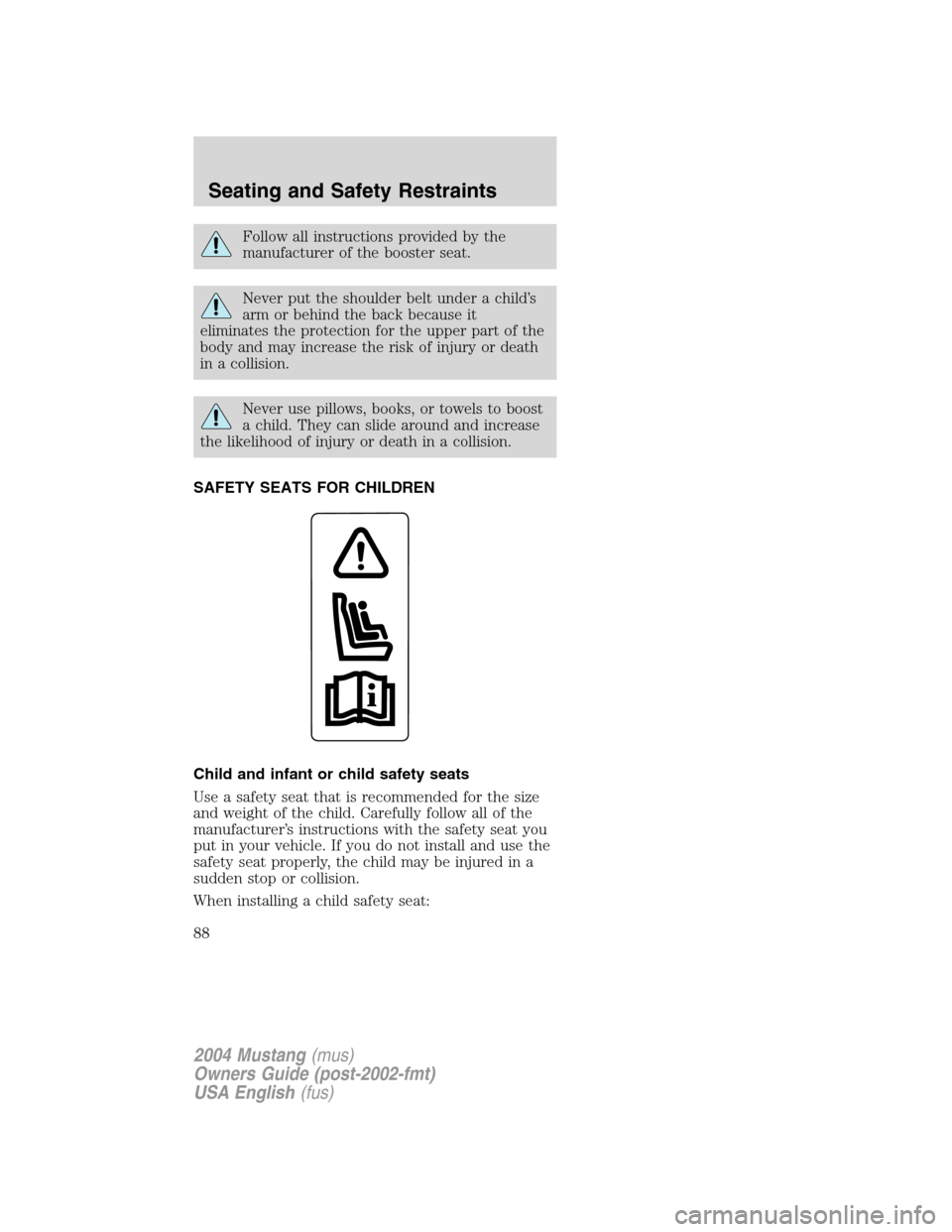
Follow all instructions provided by the
manufacturer of the booster seat.
Never put the shoulder belt under a child’s
arm or behind the back because it
eliminates the protection for the upper part of the
body and may increase the risk of injury or death
in a collision.
Never use pillows, books, or towels to boost
a child. They can slide around and increase
the likelihood of injury or death in a collision.
SAFETY SEATS FOR CHILDREN
Child and infant or child safety seats
Use a safety seat that is recommended for the size
and weight of the child. Carefully follow all of the
manufacturer’s instructions with the safety seat you
put in your vehicle. If you do not install and use the
safety seat properly, the child may be injured in a
sudden stop or collision.
When installing a child safety seat:
2004 Mustang(mus)
Owners Guide (post-2002-fmt)
USA English(fus)
Seating and Safety Restraints
88
Page 117 of 240

VEHICLE LOADING–WITH AND WITHOUT A
TRAILER
This section will guide you in the proper loading of
your vehicle and/or trailer, to keep your loaded
vehicle weight within its design rating capability,
with or without a trailer. Properly loading your
vehicle will provide maximum return of vehicle
design performance. Before loading your vehicle,
familiarize yourself with the following terms for
determining your vehicle’s weight ratings, with or
without a trailer, from the vehicle’s Safety
Certification Label and Tire and Load Information
Label:
Base Curb Weight–is the weight of the vehicle
including a full tank of fuel and all standard
equipment. It does not include passengers, cargo, or
optional equipment.
Vehicle Curb Weight–is the weight of your new
vehicle when you picked it up from your dealer plus
any aftermarket equipment.
Cargo Weight–includes all weight added to the
Base Curb Weight, including cargo and optional
equipment. When towing, trailer tongue load or king
pin weight is also part of cargo weight.
GAW (Gross Axle Weight)–is the total weight
placed on each axle (front and rear)–including
vehicle curb weight and all payload.
GAWR (Gross Axle Weight Rating)–is the
maximum allowable weight that can be carried by a
single axle (front or rear).These numbers are
shown on the Safety Compliance Certification
Label located on the driver’s door or door
pillar. The total load on each axle must never
exceed its GAWR.
2004 Mustang(mus)
Owners Guide (post-2002-fmt)
USA English(fus)
Driving
117
Page 118 of 240
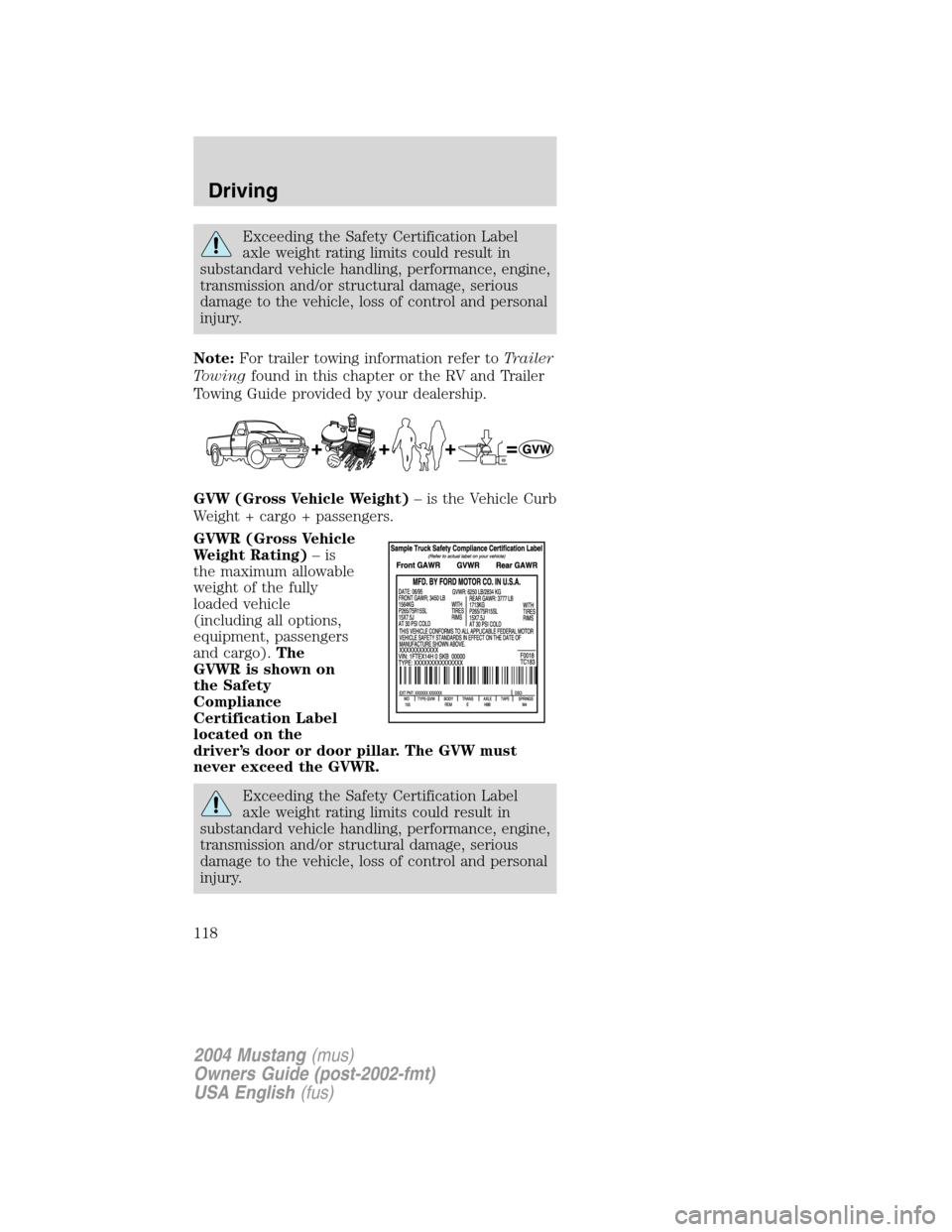
Exceeding the Safety Certification Label
axle weight rating limits could result in
substandard vehicle handling, performance, engine,
transmission and/or structural damage, serious
damage to the vehicle, loss of control and personal
injury.
Note:For trailer towing information refer toTrailer
Towingfound in this chapter or the RV and Trailer
Towing Guide provided by your dealership.
GVW (Gross Vehicle Weight)–is the Vehicle Curb
Weight + cargo + passengers.
GVWR (Gross Vehicle
Weight Rating)–is
the maximum allowable
weight of the fully
loaded vehicle
(including all options,
equipment, passengers
and cargo).The
GVWR is shown on
the Safety
Compliance
Certification Label
located on the
driver’s door or door pillar. The GVW must
never exceed the GVWR.
Exceeding the Safety Certification Label
axle weight rating limits could result in
substandard vehicle handling, performance, engine,
transmission and/or structural damage, serious
damage to the vehicle, loss of control and personal
injury.
2004 Mustang(mus)
Owners Guide (post-2002-fmt)
USA English(fus)
Driving
118
Page 119 of 240
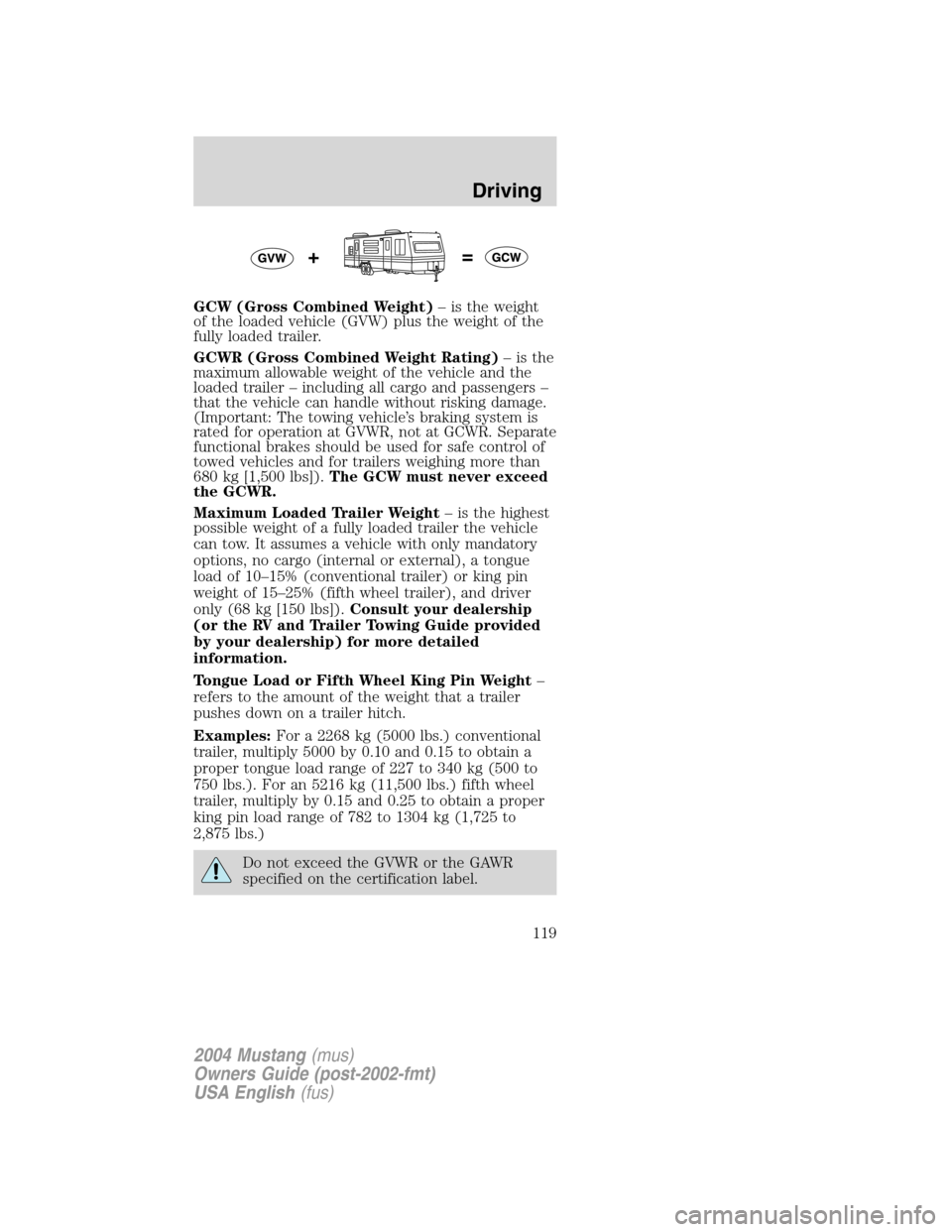
GCW (Gross Combined Weight)–is the weight
of the loaded vehicle (GVW) plus the weight of the
fully loaded trailer.
GCWR (Gross Combined Weight Rating)–is the
maximum allowable weight of the vehicle and the
loaded trailer–including all cargo and passengers–
that the vehicle can handle without risking damage.
(Important: The towing vehicle’s braking system is
rated for operation at GVWR, not at GCWR. Separate
functional brakes should be used for safe control of
towed vehicles and for trailers weighing more than
680 kg [1,500 lbs]).The GCW must never exceed
the GCWR.
Maximum Loaded Trailer Weight–is the highest
possible weight of a fully loaded trailer the vehicle
can tow. It assumes a vehicle with only mandatory
options, no cargo (internal or external), a tongue
load of 10–15% (conventional trailer) or king pin
weight of 15–25% (fifth wheel trailer), and driver
only (68 kg [150 lbs]).Consult your dealership
(or the RV and Trailer Towing Guide provided
by your dealership) for more detailed
information.
Tongue Load or Fifth Wheel King Pin Weight–
refers to the amount of the weight that a trailer
pushes down on a trailer hitch.
Examples:For a 2268 kg (5000 lbs.) conventional
trailer, multiply 5000 by 0.10 and 0.15 to obtain a
proper tongue load range of 227 to 340 kg (500 to
750 lbs.). For an 5216 kg (11,500 lbs.) fifth wheel
trailer, multiply by 0.15 and 0.25 to obtain a proper
king pin load range of 782 to 1304 kg (1,725 to
2,875 lbs.)
Do not exceed the GVWR or the GAWR
specified on the certification label.
2004 Mustang(mus)
Owners Guide (post-2002-fmt)
USA English(fus)
Driving
119
Page 120 of 240
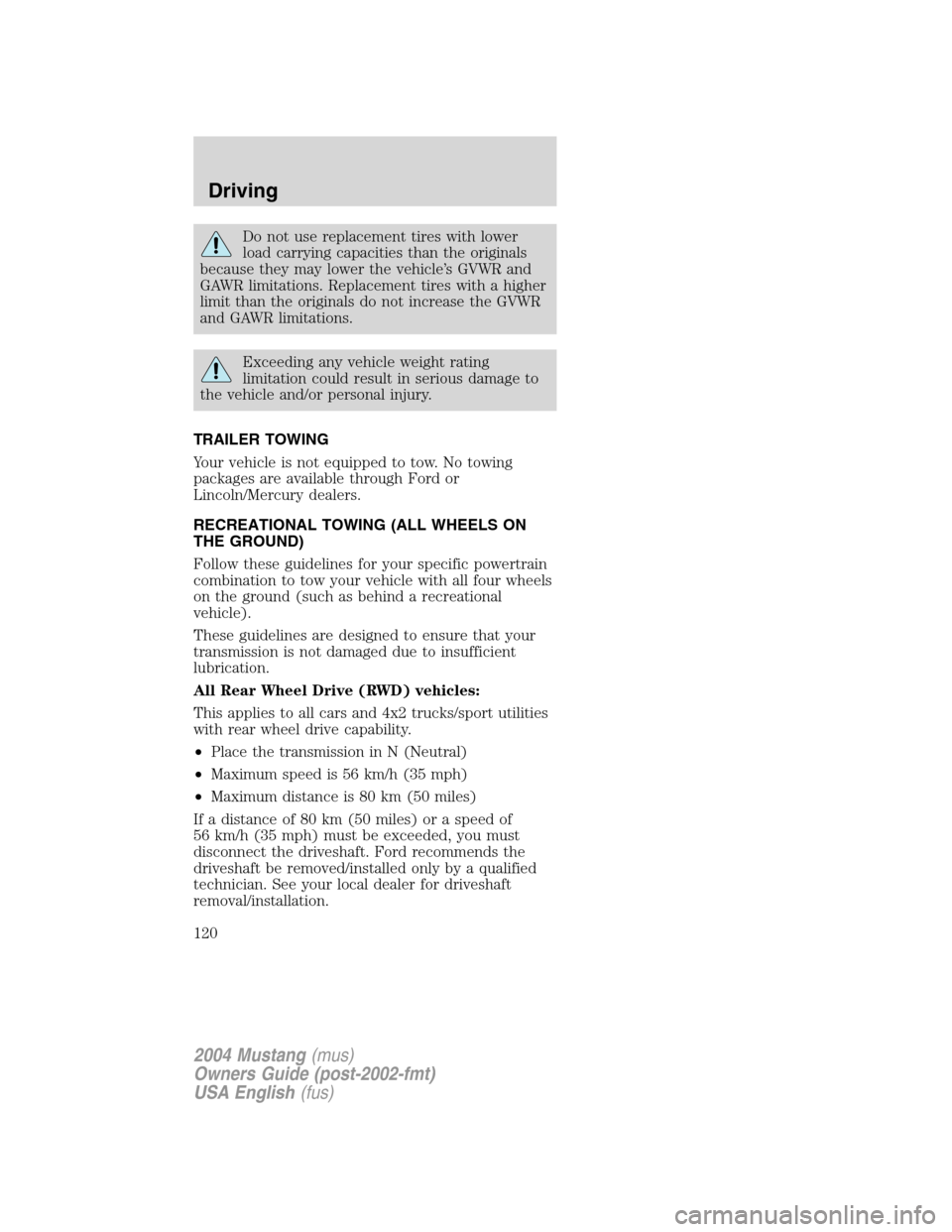
Do not use replacement tires with lower
load carrying capacities than the originals
because they may lower the vehicle’s GVWR and
GAWR limitations. Replacement tires with a higher
limit than the originals do not increase the GVWR
and GAWR limitations.
Exceeding any vehicle weight rating
limitation could result in serious damage to
the vehicle and/or personal injury.
TRAILER TOWING
Your vehicle is not equipped to tow. No towing
packages are available through Ford or
Lincoln/Mercury dealers.
RECREATIONAL TOWING (ALL WHEELS ON
THE GROUND)
Follow these guidelines for your specific powertrain
combination to tow your vehicle with all four wheels
on the ground (such as behind a recreational
vehicle).
These guidelines are designed to ensure that your
transmission is not damaged due to insufficient
lubrication.
All Rear Wheel Drive (RWD) vehicles:
This applies to all cars and 4x2 trucks/sport utilities
with rear wheel drive capability.
•Place the transmission in N (Neutral)
•Maximum speed is 56 km/h (35 mph)
•Maximum distance is 80 km (50 miles)
If a distance of 80 km (50 miles) or a speed of
56 km/h (35 mph) must be exceeded, you must
disconnect the driveshaft. Ford recommends the
driveshaft be removed/installed only by a qualified
technician. See your local dealer for driveshaft
removal/installation.
2004 Mustang(mus)
Owners Guide (post-2002-fmt)
USA English(fus)
Driving
120
Page 190 of 240
![FORD MUSTANG 2004 4.G Owners Manual •Sudden or hard accelerations may reduce fuel
economy.
•Slow down gradually.
•Driving at reasonable speeds (traveling at 88 km/h
[55 mph] uses 15% less fuel than traveling at
105 km/h [65 mph]). FORD MUSTANG 2004 4.G Owners Manual •Sudden or hard accelerations may reduce fuel
economy.
•Slow down gradually.
•Driving at reasonable speeds (traveling at 88 km/h
[55 mph] uses 15% less fuel than traveling at
105 km/h [65 mph]).](/manual-img/11/5213/w960_5213-189.png)
•Sudden or hard accelerations may reduce fuel
economy.
•Slow down gradually.
•Driving at reasonable speeds (traveling at 88 km/h
[55 mph] uses 15% less fuel than traveling at
105 km/h [65 mph]).
•Revving the engine before turning it off may
reduce fuel economy.
•Using the air conditioner or defroster may reduce
fuel economy.
•You may want to turn off the speed control in
hilly terrain if unnecessary shifting between third
and fourth gear occurs. Unnecessary shifting of
this type could result in reduced fuel economy.
•Warming up a vehicle on cold mornings is not
required and may reduce fuel economy.
•Resting your foot on the brake pedal while driving
may reduce fuel economy.
•Combine errands and minimize stop-and-go
driving.
Maintenance
•Keep tires properly inflated and use only
recommended size.
•Operating a vehicle with the wheels out of
alignment will reduce fuel economy.
•Use recommended engine oil. Refer toLubricant
specificationsin this chapter.
•Perform all regularly scheduled maintenance
items. Follow the recommended maintenance
schedule and owner maintenance checks found in
your vehicle scheduled maintenance guide.
Conditions
•Heavily loading a vehicle or towing a trailer may
reduce fuel economy at any speed.
•Carrying unnecessary weight may reduce fuel
economy (approximately 0.4 km/L [1 mpg] is lost
for every 180 kg [400 lb] of weight carried).
2004 Mustang(mus)
Owners Guide (post-2002-fmt)
USA English(fus)
Maintenance and Specifications
190
Page 202 of 240
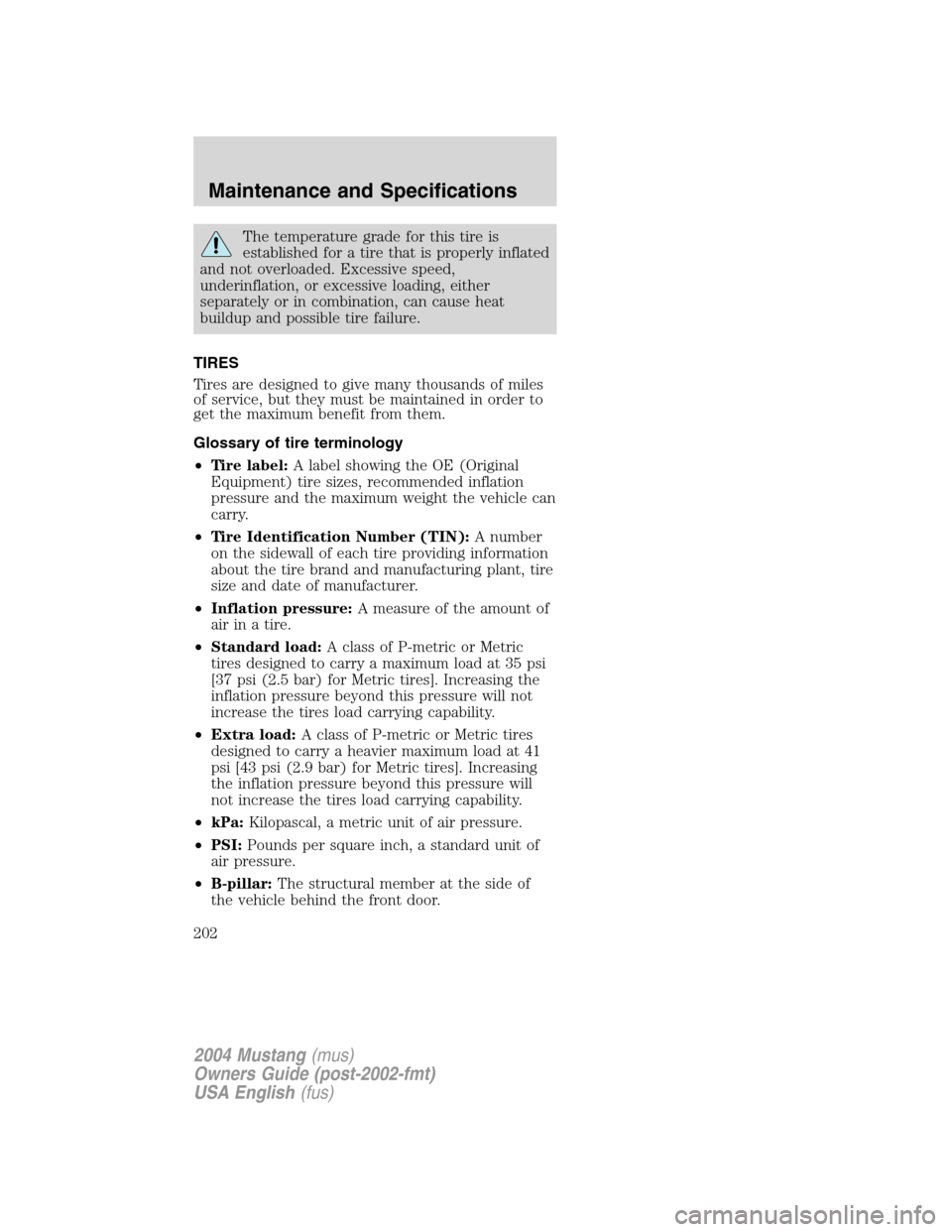
The temperature grade for this tire is
established for a tire that is properly inflated
and not overloaded. Excessive speed,
underinflation, or excessive loading, either
separately or in combination, can cause heat
buildup and possible tire failure.
TIRES
Tires are designed to give many thousands of miles
of service, but they must be maintained in order to
get the maximum benefit from them.
Glossary of tire terminology
•Tire label:A label showing the OE (Original
Equipment) tire sizes, recommended inflation
pressure and the maximum weight the vehicle can
carry.
•Tire Identification Number (TIN):A number
on the sidewall of each tire providing information
about the tire brand and manufacturing plant, tire
size and date of manufacturer.
•Inflation pressure:A measure of the amount of
air in a tire.
•Standard load:A class of P-metric or Metric
tires designed to carry a maximum load at 35 psi
[37 psi (2.5 bar) for Metric tires]. Increasing the
inflation pressure beyond this pressure will not
increase the tires load carrying capability.
•Extra load:A class of P-metric or Metric tires
designed to carry a heavier maximum load at 41
psi [43 psi (2.9 bar) for Metric tires]. Increasing
the inflation pressure beyond this pressure will
not increase the tires load carrying capability.
•kPa:Kilopascal, a metric unit of air pressure.
•PSI:Pounds per square inch, a standard unit of
air pressure.
•B-pillar:The structural member at the side of
the vehicle behind the front door.
2004 Mustang(mus)
Owners Guide (post-2002-fmt)
USA English(fus)
Maintenance and Specifications
202
Page 204 of 240

2.215:Indicates the nominal width of the tire in
millimeters from sidewall edge to sidewall edge. In
general, the larger the number, the wider the tire.
3.65:Indicates the aspect ratio which gives the
tire’s ratio of height to width.
4.R:Indicates a“radial”type tire.
5.15:Indicates the wheel or rim diameter in inches.
If you change your wheel size, you will have to
purchase new tires to match the new wheel
diameter.
6.95:Indicates the tire’s load index. It is an index
that relates to how much weight a tire can carry.
You may find this information in your owner’s guide.
If not, contact a local tire dealer.
Note:You may not find this information on all tires
because it is not required by federal law.
7.H:Indicates the tire’s speed rating. The speed
rating denotes the speed at which a tire is designed
to be driven for extended periods of time under a
standard condition of load and inflation pressure.
The tires on your vehicle may operate at different
conditions for load and inflation pressure. These
speed ratings may need to be adjusted for the
difference in conditions. The ratings range from
159 km/h (99 mph) to 299 km/h (186 mph). These
ratings are listed in the following chart.
Note:You may not find this information on all tires
because it is not required by federal law.
Letter rating Speed rating - km/h (mph)
Q 159 km/h (99 mph)
R 171 km/h (106 mph)
S 180 km/h (112 mph)
T 190 km/h (118 mph)
U 200 km/h (124 mph)
H 210 km/h (130 mph)
V 240 km/h (149 mph)
W 270 km/h (168 mph)
2004 Mustang(mus)
Owners Guide (post-2002-fmt)
USA English(fus)
Maintenance and Specifications
204